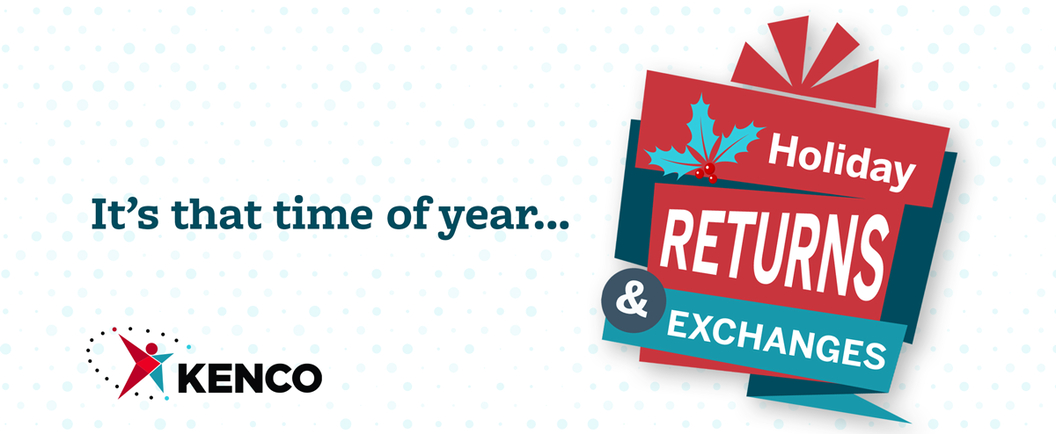
There’s a light at the end of peak season: it’s the returns train coming at you full-speed ahead.
It’s the post-holiday season, so the flow of products from retailer to consumer is now reversed. The wrong size, color, style, or scent; there are numerous reasons why gifts may not have been right. And so, the time has come: you have to deal with returns.
An estimated 2 out of 3 consumers return a gift or purchase. And returns cost businesses about 66% of the item’s original price. That’s steep.1
Returns are an inevitable part of doing business, and we all saw this looming at the end of our holiday breaks. However, returns management is a surmountable task if you enter the process understanding your product and your customers, and can keep the process as simple as possible.
A. UNDERSTAND YOUR PRODUCT
Some products, such as apparel, expect higher return rates because consumers purchase without the option of trying the products on for size. Size 8 in Brand A isn’t the same as size 8 in Brand B. Colors in online catalogs may vary according to the device on which they are viewed. Sometimes you don’t know about a product until you try it on.
According to a Shopify report, the percentage of returns for the eCommerce apparel industry is between 30-50%.2
To stem the flow of returns, retailers must consider the price points of their products to determine where to draw a line in the sand. For instance, if you sell a $10 product, and you run a sale to offer it for $5, but a return costs $4 to process, you might lose money on that return. It would be best to establish there are no returns on certain price points. But first, ensure your consumers fully understand the conditions under which they can get a great deal: the final sale is final.
Other categories of products, such as health and beauty (think soap, toothpaste, makeup), aren’t allowed to process returns to receive back into inventory. A return counts as a loss and the item must be thrown away or in some cases, donated to charitable entities. This means you need to consider the way you want your consumers to value your brand. If you sell expensive handbags, you may not want your returns to end up in the secondary market at a TJ Maxx or Goodwill. You may feel it diminishes your brand. A drug-store brand of makeup, however, might take advantage of tax write-offs from donations or sell them to the secondary market to offset some of the costs of returns.
B. KNOW YOUR CONSUMERS
Some retailers have loyal customers that see their brand as high-end and understand they may have to pay the shipping expenses to have their returns processed. Returns to these companies are carefully processed; examined for damages or stains, lint-rolled, and repackaged to be put back into inventory. Such a detailed returns process means that consumers may have their returns denied. Again, owning and enjoying the product is worth the expense of shipping the return to the retailer and the possibility of rejected returns.
Determining whether to offer free shipping and free returns processing may have to be decided through trial and error. If the returns process is difficult and expensive, this may lead to abandoned carts and low customer retention. A study by the National Retail Federation found that about 59% of retailers currently offer free return shipping.3 With Amazon offering free returns shipping, it’s sure to become table stakes in this arena. First, offer free returns processing for orders over a certain amount and see if it boosts your customer retention rate.
C. MAKE THE PROCESS SIMPLE
The more steps involved in your returns process, the more expensive it is. If there must be multiple steps in your process, as with apparel returns, make them as simple as possible.
One of our clients selling health and beauty products doesn’t have some of their returns back into the warehouse; the post office receives and donates their returns to charities on their behalf. This contrasts with the returns of high-end apparel products that may be put back into inventory. There are multiple steps in the process to ensure each item is resellable, but they’re simple enough that employees who are cross-trained on the procedures can flex in and out of the returns process to ensure the backlog remains within scope.
Again, this ties into how a retailer values their brand and how their consumers want products made available to them. Some love the thrill of the bargain hunt, while others enjoy the exclusivity associated with sales from particular retail outlets.
AN OUNCE OF PREVENTION…
Of course, the best strategy regarding returns is to prevent them in the first place. Sellers must consider their pre-sale strategies to ensure consumers are informed BEFORE clicking the buy button. Robust product descriptions, illustrative photographs, sizing charts, customer testimonials, and video reviews will help educate your buyers and steer them towards a choice they’ll be less likely to return.
If you need assistance navigating an ocean of returns, work with a 3PL with the expertise to streamline your returns management process so you can focus on growing your business next year.
3 https://www.returnlogic.com/blog/should-you-offer-free-return-shipping-data-driven-calculator/

